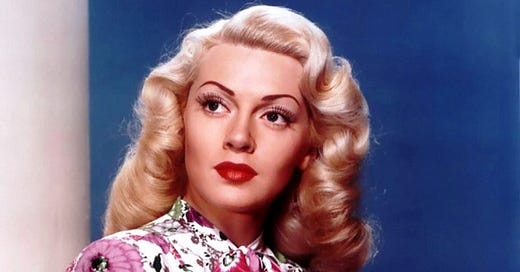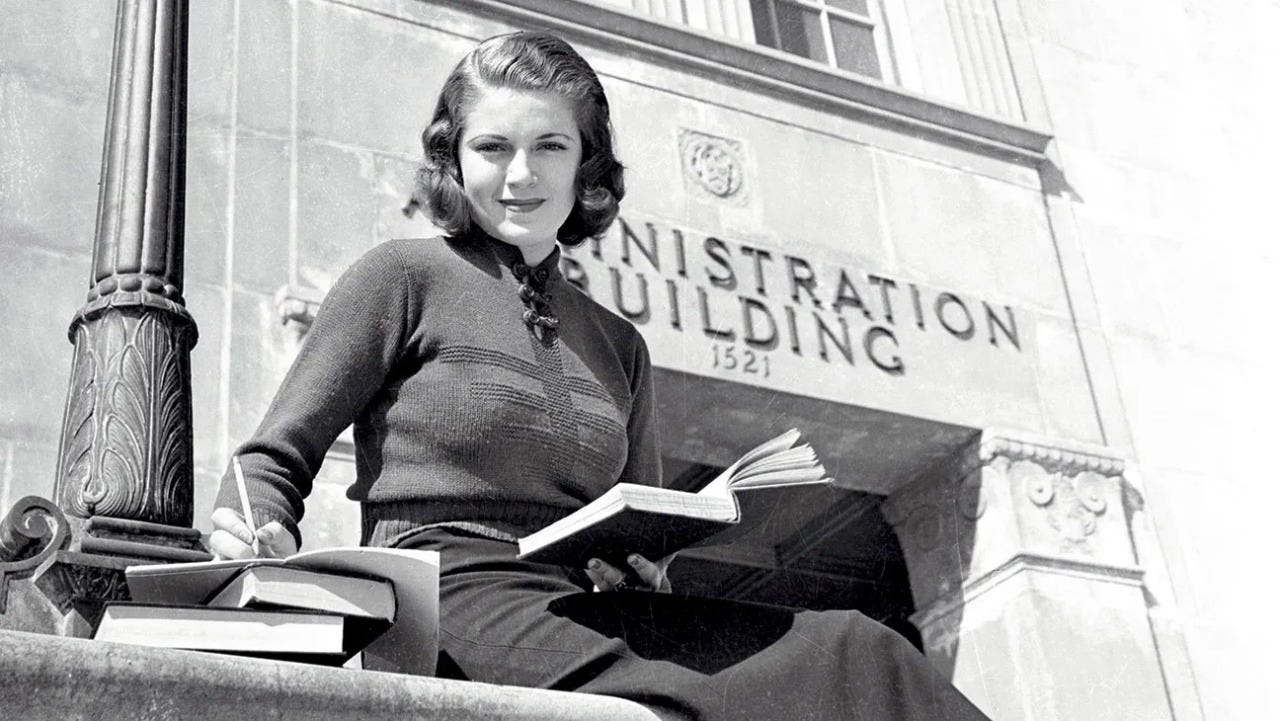(Everett)
There’s this longstanding legend that many attractive Hollywood celebrities are discovered while out and about, going along with their day. Rosario Dawson was offered a role in her first movie, Kids (1995), by director Larry Clark and screenwriter Harmony Korine while lounging on her family home’s front steps. TV star David Boreanaz was allegedly discovered while walking his dog in downtown Los Angeles. This is known as ‘the Lana Turner effect.’ The story goes that nearly a century ago, a strawberry blonde teenage girl, born Julia Jean Turner, was noticed by a studio executive who asked her if she was interested in appearing in motion pictures. What’s amazing is that, according to Lana herself, this actually happened—but at the Top Hat Malt Shop, rather than the usually attributed Schwab’s Pharmacy in retellings. Originally from Idaho, Lana’s family moved to San Francisco, CA, when she was 6 years old in 1927 and then again to LA when she was 15 in 1936. The starlet was primarily raised by her mother after her father was tragically killed outside of a local casino when she was 9 years old. Supposedly Lana was ditching class when she chose to buy a soda in the city as fate occurred in late 1936. Magazine publisher and nightclub owner William R. Wilkerson gave her name and photo to comedian Zeppo Marx, who then suggested her to director-producer Mervyn LeRoy. Despite a clumsy audition and screen test, LeRoy took her under his wing and recruited her to both Warner Bros and MGM for the next two decades.
Very quickly the ordinary American girl changed her childhood nickname of ‘Judy’ to ‘Lana’ at LeRoy’s suggestion and was cast in numerous major studio pictures, beginning with her screen debut in the crime drama They Won’t Forget (1937), directed by Mervyn. From there, roles followed in popular films like George B. Seitz’s teen romcom Love Finds Andy Hardy (1938), Harold S. Bucquet’s medical drama Calling Dr. Kildare (1939), Robert Z. Leonard’s showbiz melodrama Ziegfeld Girl (1941), Victor Fleming’s adaptation of Dr. Jekyll & Mr. Hyde (1941), LeRoy’s film noir Johnny Eager (1942) and, arguably her most iconic feature, Tay Garnett’s noir The Postman Always Rings Twice (1946). At the height of her stardom, Lana swapped her ginger locs for platinum blonde and was one of the most famous ‘sweater girls’ of the WWII era thanks to her many pin-up photoshoots. By the time she started aging out of ‘it girl’ status in her 30s, Lana impressively still managed to co-star in classics like George Sidney’s version of The Three Musketeers (1948), Vincente Minnelli’s ensemble drama The Bad and the Beautiful (1952), Mark Robson’s melodrama Peyton Place (1957), and Douglas Sirk’s social drama Imitation of Life (1959).
(Bettmann)
If there’s one thing besides her successful acting career Lana is known for, it’s her very elaborate love life. She has one of the longest lists of spouses in pop culture history with a total of 8 marriages, even after switching from Protestant to Catholic as a young adult. Amusingly, despite so many husbands, Lana only ever had one child, Cheryl Crane in 1943. Not so amusing was Lana’s terrible luck with men in her life. Following ex-beaus including many of her leading men like Clark Gable, Spencer Tracy, Robert Taylor, Victor Mature and Jimmy Stewart, as well as film producer and aviation innovator Howard Hughes; Lana’s first marriage was to bandleader Artie Shaw after he swiftly left one of her close friends, singer-actress Judy Garland in 1939. Almost immediately after marrying in early 1940, Lana and Artie divorced by the end of the year after the actress suffered a nervous breakdown during their brief, tumultuous relationship. Lana was then wed to Cheryl’s father, actor-turned-restaurant owner Steve Crane in 1942-43 and then again in 1943-44 after a brief separation. From 1948 to 1952, the star was married to millionaire Bob Topping, followed by actor Lex Barker from 1953 to 1957, whom Cheryl later accused of molesting her when she was a child at the time. Things got worse when Lana became victim of an abusive relationship with LA gangster Johnny Stompanato in 1957-58, which ended when 14-year-old Cheryl stabbed Stompanato to death while he was in the middle of hitting her mother. [The murder was eventually deemed in court as justifiable homicide.] Two low maintenance marriages followed to rancher Fred May in 1960-62 and businessman Robert Eaton in 1965-69 before Lana’s final husband was supposed hypnotist Ronald Pellar from 1969 to 1972, who was later charged and arrested for various fraud activities.
Fortunately, despite her wild and unstable personal life, Lana and Cheryl remained close all the way up to the star’s death in 1995, and the mother supported her daughter coming out as a lesbian when she was an adult. Semi-surprisingly, the blonde considered fellow movie star Tyrone Power, whom she dated in 1946-47, her one, great love and was disappointed when he left her for starlet Linda Christian. In her later years, Lana left the big screen for the stage in the 1970s and penned the 1982 memoir The Lady, the Legend, the Truth before retiring from acting in 1985. Much like blonde superstars Jean Harlow and Marilyn Monroe, Lana is a timeless icon and great beauty, but one whose artistic range and potential were never really appreciated in her prime. She was physically the perfect movie star, but she could also play flirty teenagers, seductive femme fatales, concerned mothers and distraught wives. It’s easy to get distracted by her famous exes and easily label her a victim, but Lana wanted to be seen beyond that. She was a mother who acknowledged her shortcomings and an actress who was more than a pretty face.






